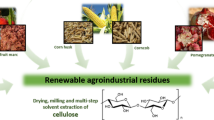Summary
As oil seeds and cereals constitute important crops in many areas wherever agriculture is practized, the varied industrial requirements from products derived from these crops, provide a continuous stimulus for agricultural and industrial research.
While progress has been made in developing varieties suited for different climatic conditions in the world, there is a pressing need for an intensified breeding program in which particular emphasis is placed not only on such features as an increased yield, earliness in maturity, high protein or oil content etc, but also on the suitability of straw and stalks for cellulose production. Therefore an attempt was made to analyse sunflower stalks for their suitability as a source for α-, β-and γ-cellulose. Besides that we were able to show that Ultra-Sonic waves can induce favorable biochemical reactions, it was logical to try if by means of such sonic treatments sunflowers could become an important source for paper-pulp and textile fiber, and become herewith a double purpose crop.
Similar content being viewed by others
Bibliography
Benett, E., 1952. The ModifiedNorman-Jenkins Method for determination of cellulose.J. Anal. Chem. Sept/Oct. 1952.
Chambers, L. A., 1938. Schallwellen als neues Hilfsmittel für Lebensmittelhersteller.Food Ind. 10,133–135.
Doree, C., 1950. The Methods of Cellulose Chemistry. Chapman and Hall Ltd., London.
Grabar, P., 1950. Action des Ultra-Sons sur les substances de masse moléculaire élevée.Nuovo cimento, supl. VII, Série IX, No 2,1–11.
Hiedemann, E., 1939. Grundlagen u. Ergebnisse der Ultraschallforschung. Verlag Walter de Gruyter u. Co., Berlin.
Holland, E. B., Reed, J. C. &Buckey, J. P. Jr., 1916.J. Agr. Res. 6,110–113.
Koon, A. W., 1941.Modern Plastics, 18,63, (Aug. 1941).
Loschke, H. &Mostowoy, K., 1942. Wie kann der Ultraschall in der landwirt. Praxis Nutzen bringen?Wien. Landwirtsch. Z., 92,43.
Lynn, J. G. et al 1944. Focussed supersonic waves in biological experiments.Electronic Eng. 17,122.
Mathews, J. M., 1924. The Textile fiber, New-York.
Matrone, G., Ellis, G. H. &Maynard, L. A., 1946.J. Anim. Sci., 5,305–12,
Naimark, G. M., et al. 1951. Bibliography on sonic and Ultra-Sonic vibrations; biological, biochemical and biophysical applications.Franklin Inst. J. 251,279–99, 402–8, F — Mr 1951.
Norman, A. G. &Jenkins, S. H., 1933.Biochem. J. 27,818–31.
Obolensky, G., 1953. Stimulation of plant growth by Ultra-Sonic waves. Radio-Electronics, New-York, July 53.
Obolensky, G., Divers Actions des Ultra-Sons en Biologie.Annee Biol., 11–12,465–521.
Obolensky, G., 1958. L'Immense Domaine d'Application des Ultra-Sons. „ATOMES“ No. 144, Mai 1956
Ott, E., 1943. Cellulose and Cellulose derivatives. New-York, 1943.
Parthasarathy, S. &Pande, E., 1945.J. Soc. Ind. Res. 3,308.
Rânby, G., 1952. The physical caracteristics of α-, β-and γ- cellulose.Svensk Papperstidn 55,115–124.
Schmidt, G., 1950. Physikalisch-chemische Wirkung des Ultraschalles. Der Ultraschall in der Medizin Bd. 2 S. Hirzel Verlag-Zürich.
Taylor, M. C., et al. 1940.Ind. Eng. Chem. 32,899–903.
Wall, P. D. et al, 1951. Changes produced in the central nervous system by Ultrasound.Science 114:686–687, D. 28.
Yasuzumi, G. andKando, A., 1951. Physico-chemical properties of the sex-chromosome, a study by means of Ultrasonic waves.J. Heredity, 42:219–223 S '51.
Rights and permissions
About this article
Cite this article
Obolensky, G. The use of ultra-sonics in cellulose production from straw, grasses and similar material. Plant Food Hum Nutr 5, 134–144 (1958). https://doi.org/10.1007/BF01099866
Published:
Issue Date:
DOI: https://doi.org/10.1007/BF01099866




